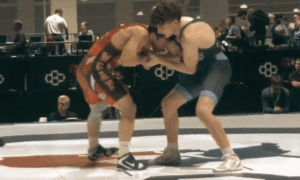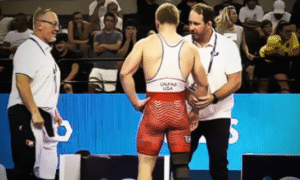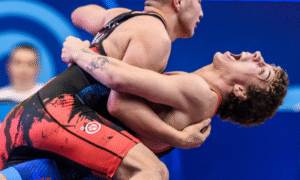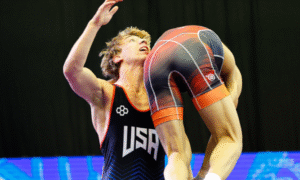Over the past year, plenty of discussion has persisted on this platform pertaining to the United States Greco-Roman program’s push to recruit more high school-aged athletes. National Team head coach Matt Lindland believes that this is a virtual necessity for the competitive health of the style in America, as the average age of World medalists depicts a downward trend. The best on the planet are getting younger, it seems, thus making it a priority for the US to somehow follow suit.
Hope, one of the most valuable of human commodities next to faith, has already arrived in the likes of G’Angelo Hancock (98 kg, Sunkist, world no. 17), Kamal Bey (75 kg, Sunkist), and Cohlton Schultz (100 kg, NYAC), perhaps the three most recognizable names associated with Lindland’s stated objective. Hancock and Bey both began their full-time Greco-Roman careers while still in high school and have achieved considerable success right out of the gate. Hancock earned a bronze medal at the Junior World Championships in 2016 and was a Senior National Team member last year, as well. Next week, he will be a favorite at the Junior World Championships in Finland and is in the medal argument for the Senior tournament in Paris a couple of weeks later. Bey, the exciting, gregarious 19-year-old, offers must-watch action and picked up a litany of titles this year switching between age groups. Schultz, a mere pug at just 16 years of age, was a Cadet World Team member last year and, like Hancock and Bey, is also on the Junior squad. Oh, and he’s got another Cadet Worlds to look forward to before the fall.
But there are other names outside of those three with whom many are familiar. Wisconsin’s Alston Nutter made news a year ago when he decided to skip his senior year of high school in order to get an early start as part of Northern Michigan University’s vaunted Greco-Roman team. Britton Holmes, the bespectacled kid from Colorado who excelled in folkstyle but sees Greco as his first love, finished his high school career in the spring and he, too, will be heading over to Marquette once the summer concludes. Hyper-talented 2016 Cadet World Team member Peyton Omania of California’s Community Youth Center is going to be part of the inaugural edition of the Elite Accelerator Program in Colorado Springs. Then there is Tommy Brackett from Tennessee, who still has a year of high school wrestling left but has made it abundantly clear Greco is the only style he will be competing in upon graduation.
Nutter, Holmes, Omania, and Brackett specialize in what you might define as authentic Greco-Roman — hips in, focused pummeling, constant action, an emphasis on upright positioning. As such, all four wrestlers have seen action against international opposition. Holmes won the Malarcupen in Sweden last fall, a mighty accomplishment for an overseas newbie. On that same tour, Nutter went 2-2 at the Klippan Cup and won his bout in a dual meet against Team Skåne Brottning. Brackett has been across the Atlantic, as well, but where he really impressed was at the US Senior Open in December, scoring a major upset victory in the first round over current National Team member and former World Team Trials finalist Courtney Myers (Army/WCAP). Omania has had the benefit of competing against European athletes every year at the Junior Greco-Roman World Duals, conveniently held at his home club.
The Domestic Greco Disconnect
All four wrestlers threw their respective hats into the ring at the 2017 Junior Fargo Greco-Roman Nationals this past weekend, and they all placed. Nutter was a runner-up in the 138 lbs category, falling to all-around prospect Mason Phillips (WA) via pin. The NMU wrestler was holding an 11-7 lead at the time and got caught on his back following a front headlock throw attempt. Omania (145 lbs in Fargo) wrestled an exciting match against another multi-style workhorse in Michigan State-bound Jaden Enriquez (CA) in the finals only to drop an 11-9 heartbreaker. Holmes lost in the quarterfinals to Enriquez but fought back for third. It was a similar story for Brackett, who was turned back by brute-tough Coloradan Myles Wilson in the quarters, forcing him to the wrestlebacks where he went the distance to take third. In fact, Brackett grabbed a measure of revenge, for it was Wilson he had defeated in the consolation final.
When it comes to Greco-Roman training and competition, this group has adopted skill-sets more congruent with how the sport is competed overseas, that whole “hips in, upright positioning” method of engagement. While it might appear the concentrated developmental opportunities availed to the above four would present a clear advantage against what are mostly moonlighting folkstylers, that is certainly not always the case. Fargo in particular does an excellent job of offering an immensely deep pool of talented wrestlers who are well-coached and can adapt on the fly. This lot of gifted competitors may only wrestle Greco a few months out of the year, but their collective abilities are far-reaching enough to where they can improvise into and out of positions on a seeming whim.
But still, given Greco’s current climate in the US along with the very fact Nutter, Holmes, Omania, and Brackett represent the National program’s plan to get younger, it is worth looking at why and how such enthusiastic (and experienced) participants in the style could falter against contemporaries lacking the same presumed acumen as they. After all, aren’t “true Greco guys” supposed to clean house in a domestic tournament?
The answer, surprisingly, is no. At least according to two of the country’s very best.
“You have to wrestle them differently”
The-now-retired-and-already-a-legend Spenser Mango and multiple-time National Team member/2012 University World Champion Max Nowry (59 kg, Army/WCAP) both know a thing or two about competing at the highest levels of the sport. Naturally, Mango requires little introduction, having ruled Greco’s lowest weight class in the US for almost a decade, made two Olympic teams, and was twice fifth at the Senior World Championships. In addition to his World gold at the University level, Nowry was also an Olympic Trials runner-up in 2012 (to Mango, no less) and has been a perennial threat each year at 59 kilograms. He’s also a National Team member (again) this year. This unique pair of wrestlers understand very well all of the elements surrounding the Fargo Greco-Roman Nationals. Mango doesn’t have a ton of history on which to fall back, but finished third and second (2003, 2004) at the mega event just as he was getting used to the international styles. Nowry’s ledger at the Fargodome is more than impressive, as he was a three-time champ in Greco and a five-timer overall.
Now, it’s important to acknowledge that Mango and Nowry competed at the Fargo Greco-Roman Nationals under slightly different conditions. While both became well-known talents and their performances at the event wound up leading to full-time careers, they had not yet experienced the same breadth of training opportunities as the young men we’re using as examples. It was only later after their histories at the tournament were written in stone did they go onto Northern Michigan and, from there, everyone knows the story. They turned out alright. Speaking to the issue at hand as it relates to committed Greco-Roman athletes falling short domestically, both gentlemen seem to feel that any consternation or worse, derision, is the result of not being aware of how Greco wrestlers who focus on the style actually train.
“Fargo is a completely different style than what these guys are used to,” says Mango. “Kids at Fargo just aren’t going to react right when they’re wrestling Greco. What I feel like always happens is that when you start training Greco full-time you’re taught, Someone’s going to react like this, someone is going to react like that or, When you do this, he’s going to do that. But that is not what happens at this tournament. I had the same problem.”
That “same problem” didn’t occur at Fargo, but somewhere else. Early on in his career at NMU, Mango entered into the FILA Junior Nationals. It was supposed to be a coronation, another declaration that he was the star of the future many believed he would grow into. Mango did become a star, the hype was real. But on that day he received a wakeup call: the specialization that Greco demands does not always translate well against the folkstyle hybrids lacing them up on US soil.
“When I lost in the FILA Juniors, I was like, What the heck? This guy didn’t do anything he was supposed to do! He didn’t react to anything right!,” remembers Mango. “But that’s the problem, because when you’re training full-time Greco, it takes a while to realize not everyone is doing what you are. When you are wrestling a folkstyle guys at Fargo who enter in Greco, you have to wrestle them differently.”
Nowry agrees and is sympathetic to the uncertainty that arises when an athlete who is coached to posture up and buck his hips forward is forced to contend with a skilled opponent who is not quite as beholden to such a stringent approach. Even if they are coached differently, seasonal Greco-Roman wrestlers have a habit of falling back to their folkstyle roots; and while that should perhaps be a disadvantage for them, it is also where the full-timers run into some confusion. The only solution in Nowry’s opinion is to embrace each instance as an opportunity for education.
“You can take lessons from certain areas,” Nowry insists. “If you’re wrestling a freestyler who’s not that comfortable with Greco and you are working a two-on-one or underhook, he has his hips back the whole time and you don’t really know what to do there. Take a guy like Nutter, he has been training at NMU the whole year, so he is used to guys who keep their hips in. Sometimes, that could take you out of your game plan. What I would do is adopt more of a standpoint on how to improve in those areas because no one wrestles the same. There are always going to be style clashes.”

Mango (left in blue) and Nowry (right in blue) both feel that US age-group wrestlers who come from focused Greco-Roman backgrounds are presented with stylistic differences at domestic events like Fargo that require adaptation. (Photos: John Sachs)
How do high expectations play a potential role?
The four athletes serving as the principles in this discussion — Nutter, Holmes, Omania, and Brackett — were not anonymous going into the Fargo Greco-Roman Nationals. It’s 2017. Information on every athlete at the tournament was widely available beforehand and it’s all but a certainty their Greco resumes were known by most, if not each one of their opponents. To say pressure factored in for the four wrestlers is still conjecture at this stage, though the idea that heightened expectations came with their participation is not unreasonable. A lot of eyes are on this event and it receives coverage like no other in the country, save for the NCAA Division I National Championships. So although a king-size microscope might not have been pointed just at this bunch in North Dakota, it is undeniable their reputations preceded them.
Nowry wonders if expectations made a difference, but for one reason — the four youngsters have battled with top-flight international competitors before, guys who have never wrestled a folkstyle match in their entire lives. American Greco enthusiasts tend to see international wrestlers as a step up from anyone they might run into domestically because of this. Plus, when delegations of US athletes do go overseas, they usually enter marquee international events boasting seasoned wrestlers from all over Europe. Thus, wrestling internationally takes the pressure off. If you perform well, super. If not, it’s all a learning experience, anyway. Obviously, an event like Fargo is approached much differently.
“I think what happens is that when these guys go up and wrestle at the higher level, they don’t really have anything to worry about so they just let it ride,” Nowry says. “But when they are expected to do well and they’re kind of put on a pedestal, the nerves get to them.” Mango feels the same way and these days owns a bird’s eye view of national competition. During his days atop the Senior ladder, it was his back where the target resided for everyone else in his weight class. In other words, Mango is keenly aware of what the wrestlers might have been tangling with inwardly before they went out on the mat. “I feel like it’s easier to be the one chasing rather than the one being chased,” he explains. “Fargo is a big deal to a lot of guys, knowing you’re probably supposed to win. And when you’re expected to win, it’s a lot tougher.”
At the end of the day, after every lineup of All-Americans is paraded out to the center mat, the lights inside of the arena go dim, and the nation waits for another year’s Fargo to make its way into the picture once again, the entire adventure is all about development. The Fargo Nationals and practically every other age-group tournament in the US is to be seen as a potential breeding ground for future Olympic hopefuls. It might be packaged in a different manner; the nature in which the event is celebrated suggests that much. But it is developmental, and whatever happens there during the course of a couple of days in July needs to be placed in the proper perspective. Especially for a few kids who already appear to know what it is they’re attempting to achieve in the long run.
“A Fargo title, whatever. I mean, Max has a room full of them (laughs), but it’s also about the bigger picture,” Mango says. “Yeah, you went, you got some matches in, some more experience, but it is all about working towards a larger goal.”
SUBSCRIBE TO THE FIVE POINT MOVE PODCAST
iTunes | Stitcher | Spreaker | Google Play Music | RSS


















